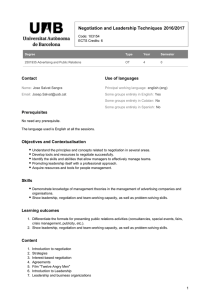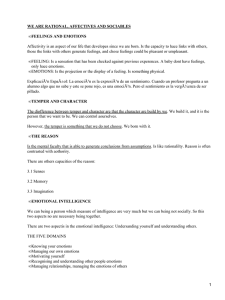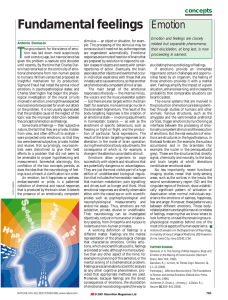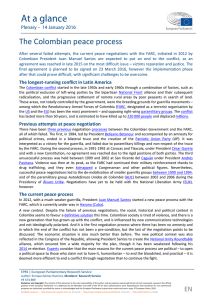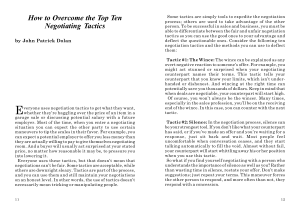Emotional responses and attitudes to the peace talks with ETA
Anuncio
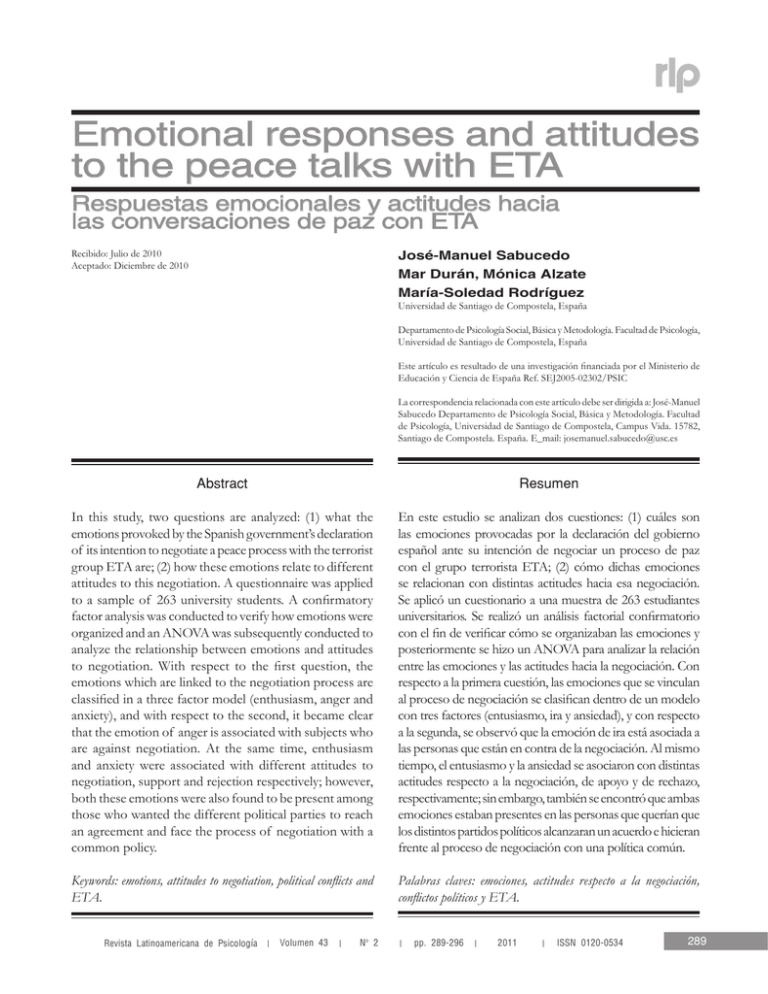
Emotional responses and attitudes to the peace talks with ETA Emotional responses and attitudes to the peace talks with ETA Respuestas emocionales y actitudes hacia las conversaciones de paz con ETA Recibido: Julio de 2010 Aceptado: Diciembre de 2010 José-Manuel Sabucedo Mar Durán, Mónica Alzate María-Soledad Rodríguez Universidad de Santiago de Compostela, España Departamento de Psicología Social, Básica y Metodología. Facultad de Psicología, Universidad de Santiago de Compostela, España Este artículo es resultado de una investigación financiada por el Ministerio de Educación y Ciencia de España Ref. SEJ2005-02302/PSIC La correspondencia relacionada con este artículo debe ser dirigida a: José-Manuel Sabucedo Departamento de Psicología Social, Básica y Metodología. Facultad de Psicología, Universidad de Santiago de Compostela, Campus Vida. 15782, Santiago de Compostela. España. E_mail: [email protected] Abstract Resumen In this study, two questions are analyzed: (1) what the emotions provoked by the Spanish government’s declaration of its intention to negotiate a peace process with the terrorist group ETA are; (2) how these emotions relate to different attitudes to this negotiation. A questionnaire was applied to a sample of 263 university students. A confirmatory factor analysis was conducted to verify how emotions were organized and an ANOVA was subsequently conducted to analyze the relationship between emotions and attitudes to negotiation. With respect to the first question, the emotions which are linked to the negotiation process are classified in a three factor model (enthusiasm, anger and anxiety), and with respect to the second, it became clear that the emotion of anger is associated with subjects who are against negotiation. At the same time, enthusiasm and anxiety were associated with different attitudes to negotiation, support and rejection respectively; however, both these emotions were also found to be present among those who wanted the different political parties to reach an agreement and face the process of negotiation with a common policy. En este estudio se analizan dos cuestiones: (1) cuáles son las emociones provocadas por la declaración del gobierno español ante su intención de negociar un proceso de paz con el grupo terrorista ETA; (2) cómo dichas emociones se relacionan con distintas actitudes hacia esa negociación. Se aplicó un cuestionario a una muestra de 263 estudiantes universitarios. Se realizó un análisis factorial confirmatorio con el fin de verificar cómo se organizaban las emociones y posteriormente se hizo un ANOVA para analizar la relación entre las emociones y las actitudes hacia la negociación. Con respecto a la primera cuestión, las emociones que se vinculan al proceso de negociación se clasifican dentro de un modelo con tres factores (entusiasmo, ira y ansiedad), y con respecto a la segunda, se observó que la emoción de ira está asociada a las personas que están en contra de la negociación. Al mismo tiempo, el entusiasmo y la ansiedad se asociaron con distintas actitudes respecto a la negociación, de apoyo y de rechazo, respectivamente; sin embargo, también se encontró que ambas emociones estaban presentes en las personas que querían que los distintos partidos políticos alcanzaran un acuerdo e hicieran frente al proceso de negociación con una política común. Keywords: emotions, attitudes to negotiation, political conflicts and ETA. Palabras claves: emociones, actitudes respecto a la negociación, conflictos políticos y ETA. Revista Latinoamericana de Psicología Volumen 43 No 2 pp. 289-296 2011 ISSN 0120-0534 289 Sabucedo, Durán, Alzate & Rodríguez Negotiation as an alternative to imposition and force as means of dealing with political conflicts can enable the reaching of agreements, which are acceptable to both sides in a conflict. However, this process is not problem-free and a high degree of social support is essential for two main reasons. Firstly, it prevents the development of social tension between those who are for and against the process in response to the problems that arise during the negotiation. This tension could seriously threaten the continuance of the process. Secondly, if the necessity for negotiation has been widely accepted, then it is easier that the concessions, which have to be made by one side to the other, are also accepted. Consequently, it is of considerable importance that peace talk processes develop in an atmosphere where there is as much social support as possible. This is even more so when the conflict in question is both violent and long-standing. One of several factors which determine whether or not support should be given to a process of negotiation is related to the advantages and disadvantages entailed by either course of action. In other words, negotiation would only be acceptable as a viable alternative when the benefits of the agreement are seen to be superior to the price that would have to be paid if the conflict continued (Zartman, 1989; Mitchell, 1997). A second important factor is how each group perceives the other. Different intergroup phenomena, such as delegitimization and dehumanization of the adversary (Bar-Tal, 2001; Oren & Bar-Tal, 2006; Staub, 1999), the depersonalization of victims (Sabucedo, Blanco, & De la Corte, 2003), or the mirror image (Bronfenbrenner, 1961) come to the fore in violent, long-standing conflicts and make any attempt to improve relations between adversaries very difficult. Thirdly here, and together with these cognitive and perceptive mechanisms, the existence of emotional aspects has also been recognized in intergroup conflicts and in their solutions (Fisher, 2000; Halperin, 2008; Valencia, Momoitio, & Idoyaga, 2010). Of the three above mentioned factors, the emotional aspect has received the least attention and apart from some mention of its relevance, there has been no systematic research to find out which emotions are involved in attitudes to political negotiation. It is, however, worth mentioning that this lack of attention is not only the case with respect 290 Revista Latinoamericana de Psicología Volumen 43 to political negotiation. In fact, there is a fairly generalized wariness of explaining any political attitudes and behaviour on the basis of evidence of emotional variables. This may be due to the opposition between emotion and reason reported by Izard (1972), which has created a situation where emotions are considered to be a serious obstacle to the correct functioning of human reason (Goodwin, Jasper, & Polletta, 2000; Marcus, Neuman, & Mackuen, 2000). Anger, however, does represent one exception to this lack of attention to emotions: it has been ascribed a significant role in both intergroup conflicts and political action (Collins, 1990; Gamson, 1992; Jagger, 1989). More recently, this situation has changed due not only to the recognition that emotions are linked to a tendency for action (Ferree, 1992; Frijda, 1988; Taylor, 1995), but also to the development of theories that go beyond a previous understanding of emotions. One of these new theories is that of affective intelligence (Marcus, 2002; Marcus et al., 2000), which is based on the ideas of Gray (1987), Damasio (1994) and LeDoux (1993) and its argument is that “emotional reactions precede rather than follow conscious perceptions” (Marcus et al., 2000, p. 35). For the purposes of this paper, the theory of affective intelligence is of interest for two reasons: firstly, it is a theory which has been devised not as a general theory of the emotions, but as an attempt to explain political behaviour from an emotional angle; secondly, it sketches out a typology of environments and of emotions related to them which may turn out to play an important role in the explanation of diverse attitudes to political negotiation (Sabucedo, Durán, Alzate, & Barreto, 2011). The theory of affective intelligence identifies three possible settings that the subject has to face. Two of these environments are familiar to the subjects in the sense that they know very well what happens in them and consequently behave in accordance with their habits and learnt routines. While one of these familiar environments is made up of people, situations, values, etc., which represent what is positive for the subject, the other is made up of what the subject fears, dislikes and rejects. There is also a third setting, in which the subjects face novel situations where preset behaviour routines do not exist. Since there is a lack of frame of reference and conduct guides in this No 2 pp. 289-296 2011 ISSN 0120-0534 Emotional responses and attitudes to the peace talks with ETA particular domain, greater attention has to be paid to both the new information and different points of view, which are to be found in this unfamiliar context. Consequently, the next step will be the identification of the emotions provoked in the different domains and of the behavioural consequences arising from each one of them. With respect to the former, Marcus et al. (2000) have shown that, faced with certain political stimuli, i.e. leaders, emotions sometimes gather in groups around three factors: enthusiasm, anger, and anxiety. These emotions relate to the familiar positive environment, the familiar hostile environment and the environment of uncertainty, respectively. This emotional structure is therefore closer to the theories of Watson, Clark and Tellegen (1988), which state that positive and negative emotions constitute different factors, than to the Valence-Arousal model where positive and negative emotions represent a bipolar factor. Another relevant point here is that on certain occasions two negative emotions, such as anxiety and anger, can be present in different factors. This would mean that emotional reactions respond to different situational demands: anxiety, being more associated with a situation of uncertainty, and anger, being linked to a situation of threat. Of course, the elements of uncertainty and/or threat occur more frequently in the context of processes of political negotiation. The second question is concerned with the politicalbehavioural consequences, which are brought into being by these emotions. As previously mentioned, both enthusiasm and anger are affective evaluations linked to familiar contexts. Consequently, subjects who respond to different political stimuli should do so by making use of their repertoire of cognitive preconceptions, mental pictures and other acquisitions made during the process of political socialization. This reaction will be characterized by “politically active” behaviour where the subjects will openly and transparently side with a viewpoint that is either for or against the issue in question (Marcus et al., 2000). Due to its own characteristics, anger will produce greater adhesion to in-group beliefs than that produced by enthusiasm. Therefore, with respect to attitudes to political negotiation, anger should lead to less flexibility than enthusiasm would. In contrast to such well-defined positions, anxiety will give rise to another type of behaviour. Given that this emotion is provoked by a context that is perceived as new, full of uncertainty and risk, some of the subjects may well find that their previous beliefs no Revista Latinoamericana de Psicología Volumen 43 No 2 longer represent an absolute guarantee of security and will consequently be attentive to all information and viewpoints that will help them find both their bearings and a path of action in this environment. Quite a long time ago, Noelle-Neumann (1973) noted that in situations of high risk, subjects looked for all types of information that could be of use to them without adhering to or being consistent with their own particular code of beliefs. This means that the “politically active” attitude characteristic of the other two emotions will be abandoned and a giveand-take strategy, which is more receptive to different ideas and more prepared to reach agreements will be chosen. Negotiation in violent, political conflicts seems to be a suitable domain in which the previously mentioned emotions become evident. Indeed, the possibility of reaching agreements that enable an end to a long cycle of violence can arouse (1) enthusiasm to reach a desired peace, (2) anger, caused both by the concessions that have to be made and by negotiating with those who have been a symbol of evil for years, and (3) anxiety for the uncertain and hazardous nature of the process. Thus, we set forth to study the possible relation of emotions and citizens’ attitudes to a negotiation with a terrorist group, in this case between the Spanish government and ETA. nd On March 22 2006, ETA announced a permanent ceasefire and a few days later the Spanish government expressed its wish to negotiate with ETA and embark on what it designated as a “peace process”. The prospect of negotiating with ETA caused a fierce social debate. The most important opponents to this negotiation were, firstly, the Partido Popular (PP), a conservative party which is presently the main opposition party, and, secondly, the Asociación de Víctimas del Terrorismo (AVT), which is the largest organization of terrorist victims in Spain.1 In this study, two questions related to the Spanish government’s negotiation with ETA will be analyzed. Firstly, which emotional structure can be identified as linked to the process; and secondly, what is the nature of the relation between emotional factor and attitudes towards negotiation. 1 The PP has turned its opposition to the peace talks with ETA into on its main lines of attack against the government. It is doing this by persistently criticizing the government in parliament and in the media, and also by taking part in demonstrations against the peace process. The AVT has been organizing demonstrations against the peace process, which they describe as an act of surrender to the terrorists. pp. 289-296 2011 ISSN 0120-0534 291 Sabucedo, Durán, Alzate & Rodríguez Results Method Sample A sample of 263 psychology students from the universities of Santiago de Compostela and the Autonomous University of Madrid were interviewed. The age range was between 20 and 42 years old with an average age of 22.2 years old. The sample was made up of 224 women and 39 men. Procedure and design An ad hoc questionnaire asking different questions related to the negotiation process was used. The questionnaire did not make any judgment of the negotiation process. Given that this subject was on the public agenda and the different political parties and social groups had made statements both in favour of and against the process, it was assumed that the subjects had already formed their own opinions about it. The heading on the questionnaire said: “What we wish to ask you about is how you feel about the forthcoming talks between the government and ETA. People have different feelings about it and we would like to know yours”. For the aims of this paper, two questions have been selected from it: Emotions. The question was: “How would you say you felt about the forthcoming talks between the government and ETA?” The emotions in question were the following: enthusiastic, bitter, offended, afraid, worried, proud, anxious, disgusted, angry, optimistic, abandoned, depressed, and sad. The answer scale included the following alternatives: none, a little, quite a lot, a lot. Imposition vs. compromise with other democratic forces. The question was: “Given that the peace talks with ETA are a controversial matter, what do you think the government should do: 1) go ahead with the negotiation process, 2) bring the negotiation process to a standstill, 3) try to reach an agreement with all the political forces so that the peace process can be continued. Individuals had to choose only one option. The questionnaire was answered collectively by the students in the university lecture halls. 292 Revista Latinoamericana de Psicología Volumen 43 Reference to the two questions relevant to this paper will be made: the organization of emotions with regard to the negotiation process between the government and ETA and the relation between these emotions and attitudes to the process. Organization of emotions Two previous theoretical models were used. The first one was bifactorial, with the first factor being made up of negative emotions (embittered, offended, frightened, worried, anxious, disgusted, angry, abandoned, depressed, sad), while the second comprised positive ones (enthusiastic, proud, optimist). The second model put forward three factors: the first factor was made up of the emotional dimension of anger, the second tallied with the second of the previous analysis –the factor of enthusiasm–, and the third factor was comprised of the dimension of anxiety. These results are in line with those we have obtained in a previous study using an exploratory factor analysis (Sabucedo, Durán, Alzate, & Barreto, 2011). In order to check which of the two models had a better fit, a confirmatory factor analysis was conducted. The Lisrel 8.7 (Jöreskog & Sörbom, 1993) program was used and a maximum likelihood estimation procedure was followed. The indices used to evaluate goodness of fit models were based on several recommended criteria (Bollen, 1989; Hu & Bentler, 1999): the χ² test, the root mean square error of approximation (RMSEA ≤. 06), the goodness of fit index (GFI ≥.95), and the comparative fit index (CFI ≥.95). In the subsequent analyses, both those emotions whose elimination contributed to an increase in the explained total variance and the items whose factor loading was distributed in a similar manner in different factors (abandoned, depressed, sad, embittered and anxious) were removed from the group of thirteen items that made up the initial scale. Using this statistical criterion, the resulting scale was made up of eight items that reached a percentage of explained variance of 77.76% in the three factor model. The goodness of fit models for the two factor models were the following: χ² (19)= 44.05, p≤.05; RMSEA =.16; GFI =.88; CFI =.90. As the goodness of fit for the model No 2 pp. 289-296 2011 ISSN 0120-0534 Emotional responses and attitudes to the peace talks with ETA of three factors was: χ² (17)= 18.04, p=.39; RMSEA =.013; GFI =.98; CFI=.99, this model is considered to have an adequate fit because it obtains indices whose values go beyond the most commonly accepted cut-off points. In contrast, the two factor model has a poor fit. The estimated parameters for the three factor model are in Figure 1. The standardized factor loadings confirmed that each of the three factors was well defined by its items. For the angry factor, which corresponds to Marcus’s aversion factor, loadings ranged from .80 (disgusted) to .90 (angry). For the enthusiasm factor, loadings ranged from .60 (proud) to .82 (optimistic). For the anxiety factor, the loadings ranged from .78 (afraid) to .83 (worried). Despite the anxiety item having been taken out of the analysis, it has been decided to continue giving the name anxiety to this factor, as its meaning is in fact the same as that proposed by Marcus et al. (2000). Moreover, Lau, and Heldman (2009) point out that afraid is similar to anxiety. One interesting piece of information is the relation of the two negative emotional factors (anger and anxiety) to enthusiasm. While the relation between anger and enthusiasm goes in the foreseeable direction (r=-.53), one can see that there is practically no relation between anxiety and enthusiasm (r=.03). What is important, however, is the relation between anger and anxiety. Emotions and attitude to negotiation In order to analyze how each emotion is associated with the different attitudes to negotiation, an ANOVA of one factor with three levels that correspond to the three possible alternative attitudes to negotiation was conducted. The criteria variables were the three emotions. The results are in Table 1. Figure 1: Model of three emotional factors. Table 1 ANOVA of emotions and attitudes to negotiation Dependent Variable F Levels Mean Continue negotiation Anger F(2,259)= 42.08* No continue negotiation Agreement Continue negotiation Enthusiasm F(2,259)= 27.90* No continue negotiation Agreement Continue negotiation Anxiety F(2,259)= 11.09* No continue negotiation Agreement 1.21 2.44 1.42 2.35 1.22 2.14 1.78 2.52 2.20 * p≤ .0001 Revista Latinoamericana de Psicología Volumen 43 No 2 pp. 289-296 Post-hoc Significance difference between the 3 levels p≤ .002 Differences between levels: 1 – 2 and 2 – 3 p≤ .0001 Differences between levels: 1 – 2 and 1 – 3 p≤ .0001 2011 ISSN 0120-0534 293 Sabucedo, Durán, Alzate & Rodríguez There are significant differences between the three groups in the anger dimension. As one can see, those who do not agree with the prolongation of negotiation are the angriest subjects, while those with the lowest score in this emotion favour the continuance of the process even without concurrence among all the parties. In the enthusiasm dimension there are significant differences between all the groups except between those who favour a continuation of negotiation and those who are inclined towards a better agreement. Therefore, those who show greater enthusiasm favour the continuance of negotiation and the pursuit of agreement. Lastly, in the anxiety dimension there are no significant differences between the groups that do not agree with the continuance of negotiation and those that favour agreement. Thus, it would appear that a greater anxiety is related with the division of the subjects between a strategy of bringing the negotiation process to an end or continuing it with the proviso of the support of all the parties. Discussion Before embarking on the discussion of the results, brief mention should be made of the sample used. Taking into account the size and characteristics thereof, the results cannot be extrapoled to the population as a whole. But that was never our aim; rather we wished to ascertain how emotions are organized when facing negotiations with a terrorist group, and how they are associated with different attitudes towards negotiation in a sample of individuals with different standpoints on the matter. These results must thus be contrasted with those obtained in other, different samples. This, however, does not invalidate the value of our results, which, conversely, are consistent with the theories alluded to in the present article. The emotions related to the Spanish government’s negotiation with ETA cannot be shown on a simple bipolar scale. The data clearly shows the existence of the three emotional factors which had been anticipated: anger, enthusiasm and anxiety. In a recent paper that evaluated the emotional reaction brought about in response to see photographs of a British citizen kidnapped in Iraq, Iyer and Oldmeadow (2006) also found a three-factor model (sympathy, fear and anger), in which the two negative factors were different. The following methodological observation can be made here, and that is that the obtained emotional structure may be the consequence of a methodological bias 294 Revista Latinoamericana de Psicología Volumen 43 resulting from an inadequate coverage of emotions in the questions and not reliably reflect the true feelings of the subjects. Because of this, and as Marcus, MacKuen, Wolak, and Keele, (2003) have correctly pointed out, although these three dimensions may not appear in all cases, it is important that the list has a wide range of emotions so that the structure which best reflects the reality in question can become evident in its totality. The three emotional dimensions that have been obtained present a clear picture of the reactions to the announcement of negotiation with ETA. Firstly, the dimension of anger is based fundamentally on the delegitimization of the terrorists as well as on a refusal to grant any political advantage either to the organization or to any of its related groups. For a part of the citizenship, and especially for those who have been victims of ETA´s violence, the memory of the pain and suffering caused by this organization makes it very difficult to accept the possibility that this group should sit down at the negotiating table with the government. Secondly, the reaction of enthusiasm would appear to be centered on the hope that the bloodshed, which has lasted for decades and has included hundreds of deaths, will be brought to an end. As in the previous case, this enthusiasm is not without a total rejection of the terrorists; however, this condemnation of ETA’s actions does not exclude support for the process in the belief that it may lead to an end to violence. The difference between the first and second emotion is more a question of their “locus.” The anger dimension focuses on the terrorists, their crimes and the suspicion that they may gain political advantages while the reaction of enthusiasm would appear to be based on both the urgency and the hope of bringing the bloodshed and fear to an end. Thirdly, the emotion of anxiety, which is characterized by fear and uncertainty when faced by a new context, would also appear, in part to be an expression of rejection of negotiation because of the correlations between the different factors. The data shows that these emotions are related with attitudes to negotiation. With respect to anger, those who are against negotiation obtained the highest score and those who supported it received the lowest. With regard to enthusiasm, those who achieved the highest score support negotiation and the reaching of an agreement. That enthusiasm should also influence the attitude towards reaching an agreement, which is not surprising in view of the fact that a peace process, such as the one that is being No 2 pp. 289-296 2011 ISSN 0120-0534 Emotional responses and attitudes to the peace talks with ETA analyzed here, will have more chance of success when a greater number of agents get actively involved in it. The attitude, which is against the process and is held by the main opposition party in Spain and by a significant part of the victims of terrorism groups, seriously threatens this possibility. Consequently, those who are dedicated to the process realize that it is necessary to reach agreements with the opposition and other relevant groups so that this important challenge can be met from a position of unity. Finally, with regard to anxiety, the highest score is split between discontinuing negotiation and reaching an agreement, hence it appears to have a double meaning. One the one hand, it appears as a manifestation of a situation that is not desired by individuals- comparable in terms of behavioural consequences with anger; and, on the other hand, it would seem to be a reaction to a new context, which is full of uncertainty. One way of facing the inevitable tension created by this new and important state of affairs is to attempt to reach the agreement of all the political forces. This agreement would be a guarantee that all the conditions of all the democratic political groups would be respected, and that negotiation would not be a reason for social tension and political confrontation. To conclude, it is important to stress that these emotions are not immutable, but are open to change. That is to say, they may change if the manner in which the negotiation process between the Spanish government and ETA is perceived and interpreted also changes. This would open the doors to the possibility that anger might become an emotion which would be more inclined towards agreement and compromise. This, however, cannot happen automatically because the citizens who are presently against the process need evidence that will enable them to perceive that the attainment of peace does not mean a renunciation of what is essential for social reconciliation –justice, truth and a recognition of the condition of the victims of terrorism–. References Bar-Tal, D. (2001). Why does fear override hope in societies engulfed by intractable conflict, as it does in the Israeli Society? Political Psychology, 22, 601-627. Bollen, K.A. (1989). Structural equations with latent variables. New York: Wiley. Bronfenbrenner, U. (1961). The mirror image in SovietAmerican relations: A social psychologist report. Journal of Social Issues, 17, 45-56. Revista Latinoamericana de Psicología Volumen 43 No 2 Collins, R. (1990). Stratification, emotional energy and the transient emotions. In T. D. Kemper (ed.). Research agendas in the sociology of emotions (pp. 27-57). Albany: State University of New York Press. Damasio, A. R. (1994). Descartes´ error: Emotion, reason, and the human brain. New York: GP Putnam´s Sons. Ferree, M. M. (1992). The political context of rationality: Rational choice theory and resource mobilization. In A. D. Morris & C. M. Mueller (eds.): Frontiers in social movement theory (pp. 29-52). New Haven, CT: Yale University Press. Fisher, R. J. (2000). Intergroup Conflict. In M. Deutsch & P. T. Coleman (Eds.). The handbook of conflict resolution. Theory and practice (pp. 166-184). San Francisco: Jossey- Bass Publishers. Frijda, N. (1988). The laws of emotion. American Psychologist, 43 (5), 349-358. Gamson, W. (1992). The social psychology of collective action. In A. D. Morris & C. M. Mueller (Eds.). Frontiers in social movement theory (pp. 53-76). New Haven, CT: Yale University Press. Goodwin, J. Jasper, J. M., & Polletta, F. (2000): The return of the repressed: The fall and rise of emotions in social movement theory. Mobilization, 5 (1), 65-84. Gray, J. A. (1987). The Psychology of Fear and Stress. Cambridge: Cambridge University Press. Halperin, E. (2008). Group-based hatred in intractable conflict in Israel. Journal of Conflict Resolution, 52, 713-736. Hu, L. & Bentler, P.M. (1999). Cutoff criteria for fit indexes in covariance structure analysis: conventional criteria versus new alternatives. Structural Equation Modeling, 6, 1-55. Iyer, A. & Oldmeadow, J. (2006). Picture this: Emotional and political responses to photographs of the Kenneth Bigley kidnapping. European Journal of Social Psychology, 36, 635-647. Izard, C. (1972). The face of emotion. New York: AppletonCentury-Crofts. Jagger, A. (1989). Love and knowledge: Emotion in feminist epistemology. Inquiry, 32, 151-176. Jöreskog, K.G. & Sörbom, D. (1993). LISREL 8: structural equation modeling with the SIMPLIS command language. Chicago: Scientific Software International, cop. pp. 289-296 2011 ISSN 0120-0534 295 Sabucedo, Durán, Alzate & Rodríguez Lau, R. R., Heldman, C. (2009). Self-interest, symbolic attitudes, and support for public policy: A multilevel analysis. Political Psychology, 30, 513-537. LeDoux, J. (1993). Emotional memory systems in the brain. Behavioral Brain Research, 58, 68-79. Marcus, G. E. (2002). The sentimental citizen: Emotion in democratic politics. University Park, PA: Pennsylvania State University Press. Marcus, G. E. MacKuen, M.; Wolak, J., & Keele, L. (2003). The measure and mismeasure of emotion. Conference on affect and cognition in political action. University of Iowa, March 6-9. Marcus, G. E. Neuman, W.R., & MacKuen, M. (2000). Affective intelligence and political judgment. Chicago: University of Chicago Press. Mitchell, C.R. (1997). Evitando daños: reflexiones sobre la situación de madurez en un conflicto. Estudios Internacionales, 8, 23-37. Noelle-Neumann, E. (1973). Return to the concept of powerful mass media. In H. Eguchi & K. Sata (comps.). Studies of Broadcasting 9. (pp. 67-112). Tokyo: NHK. Oren, N. & Bar-Tal, D. (2007). The detrimental dynamics of delegitimization in intractable conflicts: the IsraeliPalestinian case. International Journal of Intercultural Relations, 31 (1), 111-126. 296 Revista Latinoamericana de Psicología Volumen 43 Sabucedo, J. M., Blanco, A., & de la Corte, L. (2003). Beliefs which legitimize political violence against the innocent. Psicothema, 15, 550-555. Sabucedo, J. M., Durán, M., Alzate, M., & Barreto, I. (2011). Emotions, ideology and collective political action. Universitas Psychologica, 10 (1), 27-34. Staub, E. (1999). The roots of evil: The origins of genocide and other group violence. New York. Cambridge University Press. Taylor, V. (1995). Watching for vibes: Bringing emotions into the study of feminist organizations. In M. M. Ferree & P. Y. Martin (eds.): Feminist organizations: Harvest of the new women´s movement. (pp. 223-233). Philadelphia: Temple University Press. Valencia, J-F., Momoitio, J., & Idoyaga, N. (2010). Social representations and memory: the psychosocial impact of the Spanish “Law of memory” related to the Spanish Civil War. Revista de Psicología Social, 25, 73-86. Watson, D., Clark, L., & Tellegen, A. (1988). Intraindividual and interindividual analyses of positive and negative affect: their relation to health complaints, perceived stress, and daily activities, Journal of Personality and Social Psychology, 54 (6), 1063-1070. Zartman, I.W. (1989). Ripe for resolution. Conflict resolution in Africa. Nueva York: OUP. No 2 pp. 289-296 2011 ISSN 0120-0534
